
Global Weekly Economic Outlook: Markets Navigate Shutdown Uncertainty and Earnings Finale
Global markets enter the new week balancing fragile optimism with lingering risks. Our global economic outlook looks at how cooling inflation, shifting central bank expectations, and mixed growth data from the US, Europe, China, and emerging markets are shaping sentiment across currencies, bonds, equities, and commodities. From geopolitics and energy prices to institutional positioning and upcoming data releases, this week’s roadmap highlights the key themes and indicators traders and investors should watch to navigate volatility with more confidence.
U.S. Economic Review
The U.S. economy remains in a holding pattern as the record-long government shutdown continues to suspend key official data, leaving analysts reliant on private-sector metrics. These measures suggest that activity is soft but stable — not deteriorating sharply yet lacking convincing momentum.
In the labor market, ADP reported a gain of 42,000 private-sector jobs in October after a 29,000 loss in September, though the three-month average hiring pace dropped to just 3,000. Large companies remain the primary source of job creation, while small firms continue to shed workers. Revelio Labs data showed a 9,000 decline in total employment, and the ISM services employment index stayed below 50, signaling contraction. Despite weak hiring, layoffs are limited: initial jobless claims remain near seasonal norms, though announced job cuts rose to 153,000 in October, pushing the 2025 total above one million—the highest since 2020. Many firms are trimming costs through attrition rather than layoffs, reflecting cautious sentiment amid rising costs and tariff-related pressures.
Businesses across manufacturing and services reported higher input costs and supply disruptions tied to tariffs, especially for engineered goods. The Supreme Court’s ongoing review of the Trump-era tariffs has added policy uncertainty, with betting markets now giving just a 25% chance the tariffs will be upheld. The uncertainty surrounding the ruling is weighing on corporate planning and hiring decisions.
Recent activity data highlights the mixed economic picture. The ISM Non-Manufacturing PMI held at 52.4, signaling moderate expansion in services, while manufacturing contracted again with a 48.7 PMI reading. S&P Global’s composite PMI (54.6) suggests broader resilience, but momentum remains uneven. Auto sales held steady at 15.3 million units annualized, and the Atlanta Fed’s GDPNow model points to 4.0% growth for Q4, though that estimate may soften as official data resume.
Consumers remain cautious: the Michigan sentiment index stayed depressed at 50.3, with inflation expectations at 4.7% for one year ahead and 3.6% over five years. Credit use rose moderately (+13.09B in September), and mortgage rates stabilized near 6.3%, keeping affordability tight.
U.S. economic outlook
The U.S. economic outlook for the week of November 9–15, 2025 points to steady but cautious conditions as investors await new inflation data and labor market indicators, while the prolonged government shutdown continues to limit official reporting.
Markets will be closed on Tuesday, November 11 for Veterans Day, but the week’s focus will be focused on small-business sentiment, inflation, and consumer activity. The NFIB Small Business Optimism Index, due Tuesday, is expected to edge down to around 98.2 from September’s 98.8, as small firms grow more cautious amid political uncertainty and high borrowing costs. While hiring plans remain positive and price pressures moderate, expectations for future sales and expansion have weakened, suggesting rising unease in the business sector.
The main spotlight will be on Thursday’s October CPI report, projected to show +0.3% month-over-month headline inflation and +0.2% core, keeping the annual rate near 3%. The data should reinforce the view of gradually cooling inflation, though not yet at the Federal Reserve’s 2% target. Weekly jobless claims are expected to stay within 230,000–240,000, signaling continued labor market stability despite slower hiring momentum.
On Friday, a busy data day, Producer Price Index (PPI) is forecast to rise 0.1–0.3%, indicating lingering service-sector cost pressures, while October retail sales are seen increasing 0.0–0.5%, showing moderate consumer demand heading into the holiday season. The National Retail Federation expects holiday sales to rise 3.7–4.2% year-over-year, suggesting consumers remain resilient despite tighter credit and elevated prices. The U.S. Monthly Budget Statement will also provide insight into fiscal balances, though it may face release delays due to the shutdown.
Meanwhile, several Federal Reserve officials will speak throughout the week, potentially clarifying policy direction. Chair Jerome Powell recently emphasized a data-dependent approach, noting that while the economy appears stronger than expected, a December rate cut is not guaranteed. Overall, the week’s data and commentary will test the Fed’s soft-landing narrative amid persistent inflation and political uncertainty.
Wall Street & USD Outlook — Week of November 9–15, 2025
U.S. stocks entered November on a cautious footing after a strong autumn rally. The S&P 500 has slipped about 2–3% from its October 28 record high as investors locked in profits amid renewed concerns over inflated tech valuations and the so-called “AI bubble.” Technology shares led the pullback, while broader earnings performance remained impressive — roughly 82.5% of S&P 500 companies beat forecasts, marking the strongest beat rate since mid-2021. Upcoming results from Disney and Cisco on November 12 and Nvidia next week could inject fresh volatility.
Attention has now turned to the Federal Reserve, where traders are reassessing the timing of further rate cuts. After two reductions in October, futures currently imply about a 65% chance of another cut in December, down from near certainty earlier in the fall. Fed Chair Jerome Powell struck a balanced tone, noting that additional easing is “not a foregone conclusion.” The 10-year Treasury yield remains near 4.09%, easing slightly amid uncertainty, with this week’s CPI report likely to guide market direction. Overall sentiment on Wall Street is guarded, with most analysts interpreting the recent dip as healthy profit-taking rather than a sign of reversal.
The Nasdaq remains in a medium-term uptrend that began in early July, climbing from roughly 21,000 toward the 26,000–26,300 range along a steady rising trendline. However, since early November, the index has slipped below that trendline, signaling a potential shift from bullish to short-term bearish momentum. Recent candles show consolidation just below the 26,300 peaks, followed by two strong declines pulling prices back toward the 25,000–25,200 zone—now acting as immediate support. Additional support is seen at 23,970 and 23,080. The most recent candle shows a lower wick, hinting at buying interest on dips, but the weak closing suggests the market is in a corrective phase rather than preparing for a breakout. Key resistance sits near 26,000, with support at 25,000, 23,970, and 23,080. The near-term tone is corrective, but holding above 25,000 keeps the broader structure intact.
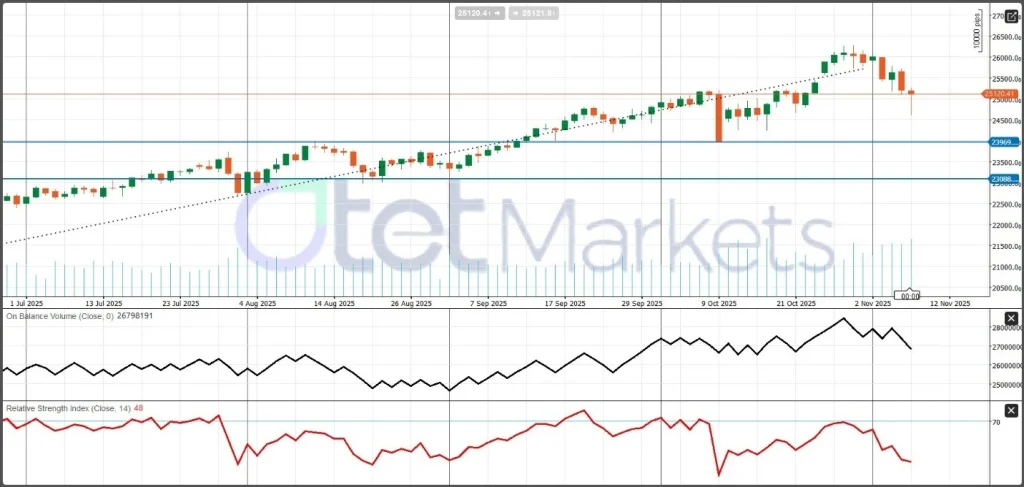
USD Index – Technical Review
The USD Index remains in a bullish medium-term trend while trading above its 20-day EMA near 99.00. The index recently tested the 100.00–100.90 resistance zone but failed to break through, prompting a pullback toward 99.40. This suggests a typical correction within a broader uptrend. • Major resistance: 100.00 and 100.90 (recent highs) • Support levels: 99.0–99.2 (near EMA), followed by 98.00 and the 96.00–96.20 area The On-Balance Volume (OBV) remains broadly supportive but has started to flatten, signaling reduced buying pressure after the strong rally. Meanwhile, the RSI (14) sits around 59, cooling from overbought territory but still consistent with a healthy bullish bias. As long as prices hold above the 98–99 support range, the medium-term outlook remains constructive. In the short term, a bounce from ~99 toward 100 would reinforce the uptrend, whereas a decisive break below 98 could trigger a deeper pullback toward the mid-96s.
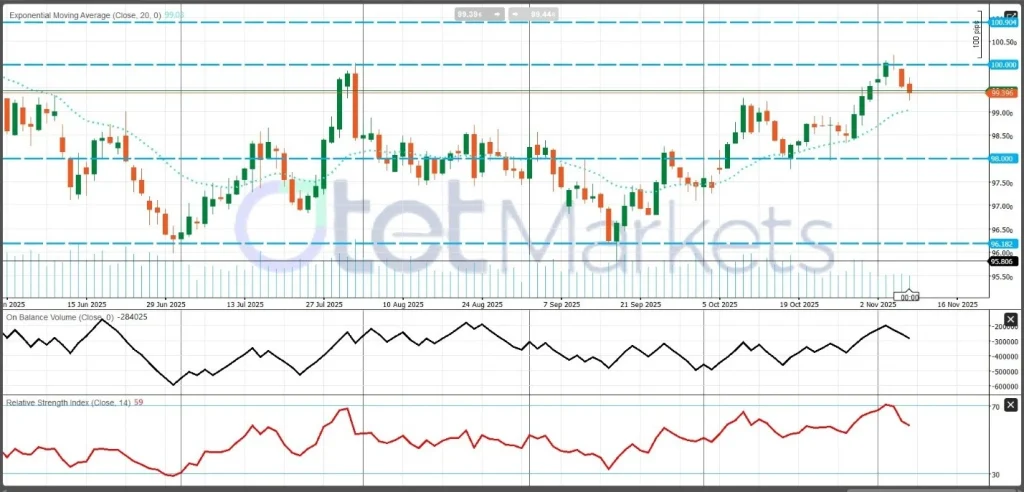
UK Economic Overview & Outlook
The UK economy remains in a delicate balance as growth slows, inflation continues to ease, and policymakers at the Bank of England (BoE) tread cautiously. At its November meeting, the Monetary Policy Committee (MPC) voted 5–4 to hold the Bank Rate at 4.00%, aligning with expectations but revealing a near-even split that underscores internal divisions over when to begin easing. The accompanying Monetary Policy Report carried a slightly dovish tone, with the Bank acknowledging that economic activity is “below potential” and reaffirming expectations for a gradual downward path in interest rates if disinflation persists.
The BoE revised its 2025 inflation forecast slightly lower to 3.5% (from 3.6%), while projections for 2026 and 2027 were left unchanged. Growth expectations improved modestly, with GDP now forecast to rise 1.5% in 2025 (up from 1.2%) and 1.6% in 2027, while unemployment is projected to edge up to 5.0% in 2025–2026. The Bank’s decision came ahead of the Autumn Budget (Nov 26), which is expected to be disinflationary and could temper near-term growth. With one more meeting scheduled in December, the BoE is expected to maintain flexibility, potentially beginning a measured easing cycle later in Q4 2025, followed by additional cuts in early 2026.
Recent activity data show a mixed picture. PMIs highlight a services-led expansion (services 52.3, composite 52.2) offset by manufacturing softness (49.7) and construction contraction (44.1). Consumer demand remains weak, with car registrations up just 0.5% YoY. Housing is stable but constrained by high borrowing costs, as the average mortgage rate remains around 6.78%, and house prices are rising modestly (+0.6% MoM, +1.9% YoY).
Looking ahead to the week of November 9–15, attention turns to key data releases. The Labour Market Report (Nov 11) is expected to confirm a gradually cooling job market, with unemployment edging toward 4.9% and pay growth easing to 3–4%. The Q3 GDP estimate (Nov 13) should show sluggish growth of about 0.2% q/q, supported by modest household spending but capped by flat industrial and construction output.
Inflation remains on a downward trajectory, averaging 3.6% in Q4 2025 and expected to approach 2.3% by late 2026, aided by softer energy and input costs. Retail sales rose 1.5% y/y in Q3, hinting at some resilience, though higher taxes and weaker real incomes may limit momentum into winter. Overall, the UK appears to be settling into a soft-landing phase, with restrained growth, easing inflation, and cautious BoE preparing for gradual rate cuts.
Bank of England – Policy and Commentary
A series of scheduled public appearances by Bank of England (BoE) officials this week will draw attention but are not expected to produce new policy signals. These engagements may provide context on the Bank’s views regarding inflation persistence, wage dynamics, and timing for future rate adjustments, but no policy shifts are anticipated.
At its November meeting, the Monetary Policy Committee (MPC) voted 5–4 to hold the Bank Rate at 4.00%, maintaining a cautious easing bias. Policymakers acknowledged a cooling inflation trend and a softening labor market but warned of a potential “bumpy landing”—where inflation moderates yet growth stagnates. This close split highlights internal debate over whether the slowdown justifies earlier rate cuts.
A Reuters survey in October showed most economists expect the BoE to hold rates steady through year-end, with two cuts likely by mid-2026. Consensus forecasts point to GDP growth of 1.4% in 2025, 1.2% in 2026, and inflation easing toward 3.6% by end-2025, with unemployment stabilizing near 4.9%. The Bank is likely to wait for the Autumn Budget (Nov 26) and the next rounds of labor and inflation data before signaling the start of policy easing.
In FX markets, GBP/USD remains under pressure within a broad range. The pair has fallen from repeated 1.34 rejections to the 1.30–1.3050 support zone, where buying interest emerged. The rebound to 1.3160 appears corrective, as the trend remains bearish below 1.3200. RSI near 40 and softening On-Balance Volume confirm limited upside momentum. A drop below 1.30 would be 1.29, while recovery above 1.32 could extend toward 1.34—but overall, the outlook favors short-term rebounds within a broader downtrend.
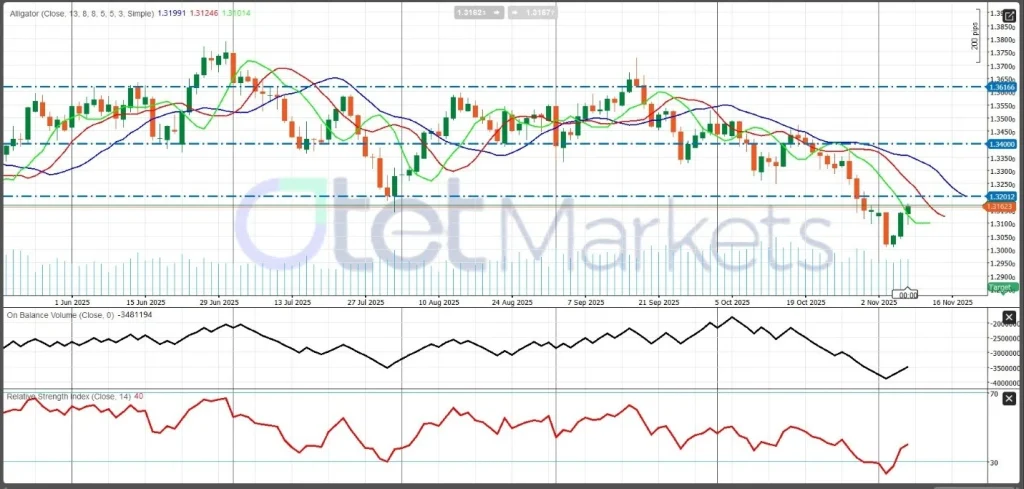
Gold Market Overview and Outlook
Gold has surged to near $4,000 per ounce in early November, marking an extraordinary 50% year-to-date gain and approaching its October record high around $4,380/oz. The rally reflects investors’ growing preference for safe-haven assets amid global uncertainty, volatile equity markets, and slowing economic growth. Lower real interest rates and persistent inflation fears have amplified demand, while the Federal Reserve’s October rate cut to 3.75–4.00%—and expectations for another cut in December—have reduced the opportunity cost of holding gold. A weaker U.S. dollar has further enhanced its global appeal.
Much of 2025’s rally stems from portfolio reallocation away from overvalued technology stocks, especially after recent corrections in AI-related equities. Analysts view the early November consolidation as healthy within a broader bullish trend, with most projecting year-end targets between $4,300 and $4,400, assuming continued Fed easing. Central banks remain major buyers, with Q3 purchases totaling about 220 tons, up 28% quarter-over-quarter, led by emerging markets such as Kazakhstan, Brazil, and Turkey, as well as European institutions like Poland. These moves reflect an accelerating de-dollarization trend amid geopolitical fragmentation.
Macroeconomic factors continue to underpin gold’s momentum. With U.S. inflation still near 3%, markets expect at least one more rate cut, keeping real yields subdued. Global growth remains tepid—around 1.2% for 2025, according to the OECD—while rising debt burdens reinforce gold’s role as a long-term store of value. Any hawkish surprises from the Fed or unexpected inflation spikes could, however, temper gains.
Geopolitical tensions—from the ongoing Russia-Ukraine war to renewed Middle East instability—have fueled safe-haven demand. U.S. political risks, including the prolonged government shutdown and trade disputes, have further strengthened gold’s defensive bid.
Institutional participation remains robust. Gold-backed ETFs have posted five consecutive months of inflows, adding roughly $8.2 billion in October alone, while speculative funds have increased long futures positions. Central bank accumulation and strong Asian demand, especially from China, suggest the rally is structural rather than speculative, driven by enduring fiscal and geopolitical instability.
In the week ahead, traders will monitor U.S. CPI, PPI, and employment data, along with Fed speeches and minutes, for clues on future policy. Meanwhile, any escalation in global conflicts or U.S. political tensions could trigger renewed safe haven buying, keeping gold firmly supported near record highs.
Gold remains in a solid medium-term uptrend, consolidating near $4,000 after a powerful rally from $3,200 to October’s $4,380 peak. The RSI (51) and flattening OBV suggest cooling momentum but no selling pressure. Prices sit just below the 20-day EMA ($4,006) and above the 50-day EMA ($3,880), indicating a healthy pause within a bullish structure. Resistance lies at $4,045–$4,050 and $4,150, with a breakout potentially retesting the record high. Support is seen at $3,875–$3,900, then $3,750–$3,800. Overall, the market appears to be consolidating within an ongoing, well-supported uptrend.
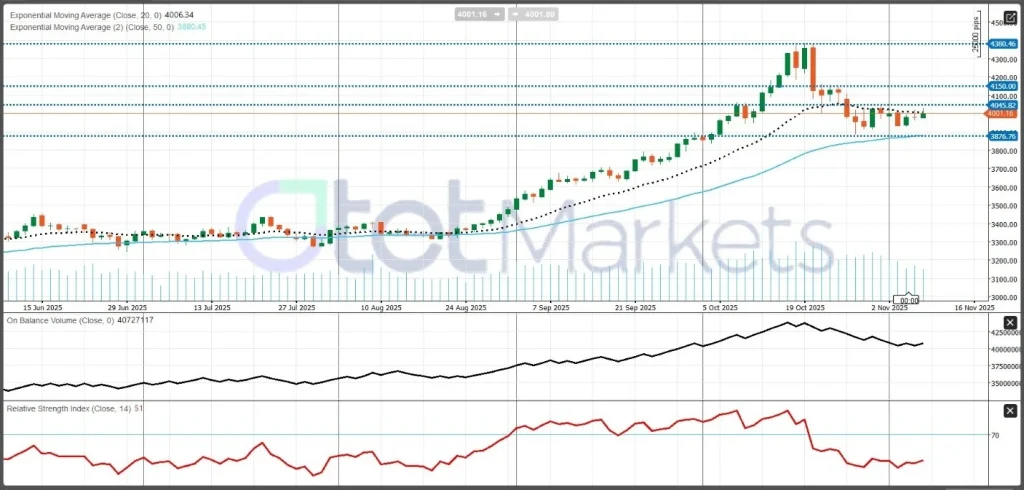
Energy Market & WTI Crude Oil Summary
WTI crude oil continued to trade under pressure in early November 2025, hovering near $61 per barrel, its lowest level in six months after sliding from the mid-$70s earlier in the year. The market tone remains cautious as traders weigh persistent oversupply risks against weak global demand. October marked the third consecutive monthly decline, with OPEC+ easing voluntary production cuts and U.S. inventories climbing steadily.
At its November 4 meeting, OPEC+ announced a modest 137,000 bpd increase for December, coupled with a pause on further hikes in early 2026. While the move signals measured restraint, it also underscores the group’s shift away from aggressive supply curbs. The IEA warned that global markets could face a 4 million bpd surplus in 2026 if current production trajectories hold. Although major banks such as Morgan Stanley raised long-term forecasts, most analysts remain wary. Meanwhile, U.S. crude output hit a record 13.6 million bpd in July and is expected to remain high into 2026. Hedge funds have also turned net short on WTI and Brent, reflecting the broader bearish sentiment.
On the demand side, global consumption growth is muted. OPEC projects a 1.3 million bpd increase in 2025, mostly from non-OECD nations. The U.S. continues to see weak industrial activity, while China’s oil demand has softened amid its slower economic growth and push toward cleaner energy. Reflecting this environment, Saudi Aramco cut December selling prices for Asian buyers, reinforcing the perception of a well-supplied market.
Geopolitical tensions have provided only short-lived support. The June Israel–Iran clash briefly lifted prices, but fundamentals quickly reasserted control. The Russia–Ukraine conflict and related sanctions remain key risks, but increased output from other OPEC+ producers has offset much of Russia’s shortfall.
From a macro perspective, a strong U.S. dollar continues to weigh on oil, while slower global growth and weaker Chinese demand limit upside potential. However, fiscal stimulus or stronger travel demand could provide short-term relief.
Inventory data remains critical. The API reported a 6.5-million-barrel build, while the EIA confirmed a 5.2-million-barrel increase in early November, signaling weaker refining activity. The Baker Hughes rig count rose slightly to 414 oil rigs, showing steady U.S. production despite price softness.
Technically, WTI crude oil remains locked in a bearish trend, trading below both its 50-day (~$61.30) and 200-day (~$64.90) EMAs, which continue to slope downward. Since early August, the market has formed lower highs and lower lows, signaling persistent selling pressure. After a failed rebound near $62.50, prices slipped back toward $59–$60, where momentum has faded. Resistance lies at $61.30, then $63.20–$65.00, while key support holds around $57.00—a break below could trigger another decline. Overall, the outlook stays bearish, with any rallies likely to meet resistance unless prices regain the 50-day EMA on strong volume.
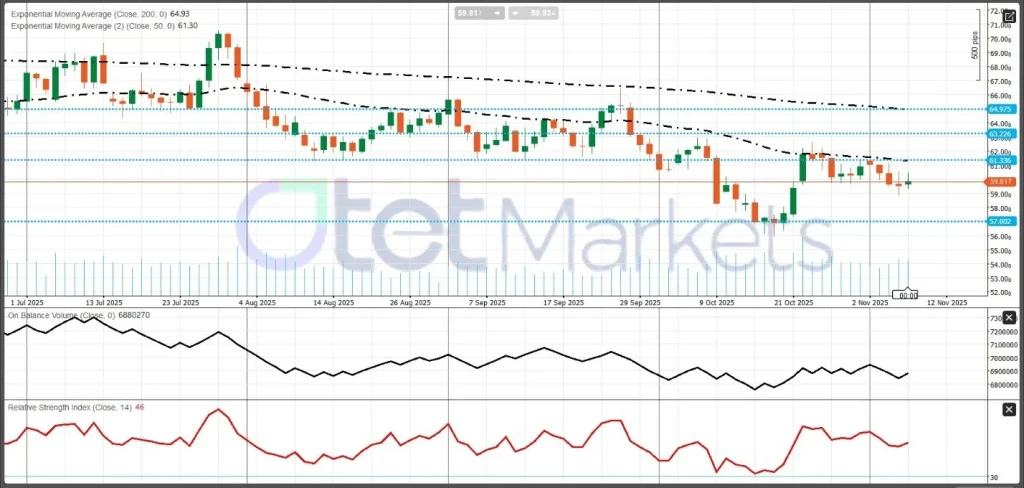
Cryptocurrency Market – Bitcoin Summary
Bitcoin has experienced a volatile autumn, peaking above $126,000 per coin in early October 2025 before retreating roughly 20% to trade around $100,000 in early November. The correction reflects a broader risk-off sentiment across markets, particularly in tech and high-growth assets, amid the prolonged U.S. government shutdown. While gold rallied as investors sought safety, Bitcoin’s pullback highlights its ongoing sensitivity to macro and political uncertainty.
Institutional Investment Flows
Institutional participation remains a defining theme. Late 2025 brought record inflows of $5.95 billion into crypto funds, with $3.55 billion directed into Bitcoin ETFs during the week ending October 4. Following a brief pause during the shutdown, U.S. spot Bitcoin ETFs saw renewed inflows of $240 million on November 7, underscoring strong demand from major asset managers such as BlackRock (IBIT). Surveys show that more than half of hedge funds now hold crypto exposure, while an increasing number of corporations—especially in tech—maintain Bitcoin reserves. Despite volatility, ETF flows indicate persistent institutional confidence, framing Bitcoin as a strategic long-term asset.
Macroeconomic & Regulatory Landscape
Bitcoin’s performance continues to hinge on monetary policy and liquidity conditions. Expectations of further Fed rate cuts and the “debasement trade”—investors hedging against expanding money supply—have supported its appeal. Conversely, a stronger dollar or hawkish Fed could limit potential upside. The ongoing U.S. shutdown has reduced liquidity, restraining speculative flows.
Regulatory conditions have improved markedly. The SEC’s approval of spot Bitcoin ETFs and a clearer stance on crypto products (like liquid staking) have enhanced market sentiment. Globally, Switzerland, the UK, Japan, and the EU (via MiCA) are building structured frameworks, signaling a more mature regulatory environment and reinforcing Bitcoin’s institutional legitimacy.
Global Adoption & Outlook
Retail adoption remains robust across emerging markets such as India, the Philippines, and Brazil, fueled by fintech accessibility. Corporate and even central-bank interest continues to rise, though Bitcoin remains primarily a store of value.
In the near term, traders will watch U.S. economic data, Fed signals, and ETF flows. Sustained inflows and easing expectations could trigger renewed upside. Without major catalysts, Bitcoin is likely to consolidate between $95K and $105K, with a break above $110K–$120K signaling potential for new highs.
Bitcoin – Technical Summary
Bitcoin has entered a clear downtrend since mid-October, falling from the $118K–$126K zone to trade around $100K–$104K. The Alligator indicator confirms a bearish setup, with price trading below all key moving averages. While the broader trend remains negative, Bitcoin is attempting to form a base near $100K, which has repeatedly held as strong support. As long as price stays below $107.2K, rebounds are likely corrective rather than the start of a new uptrend. Resistance levels stand at $104K and $107.2K, with further upside targets near $115K–$118K and $126K, while a break below $100K could trigger deeper losses.
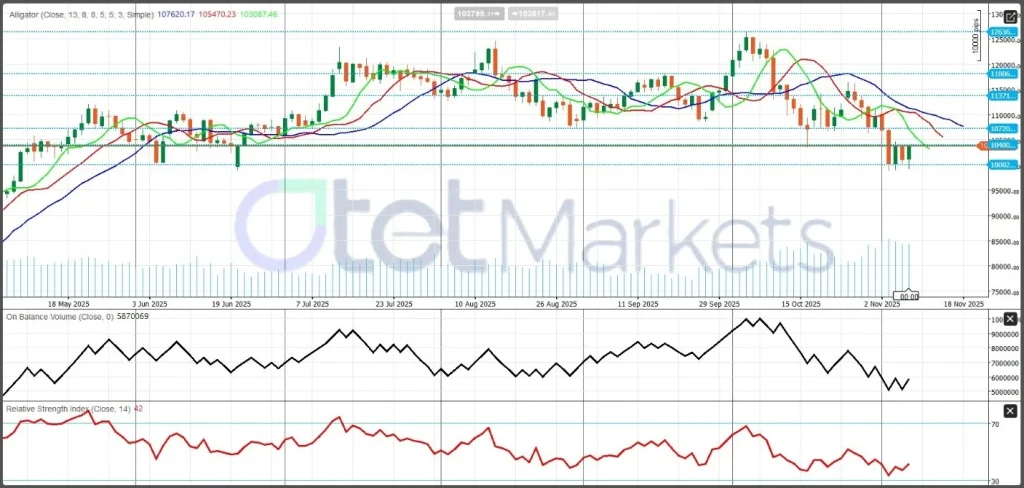
Share
Hot topics

Best Forex Trading Hours for Iranian Traders
The Forex market operates 24-hours a day, but clearly not every hour, equal it could even be every trading session, is profitable. There are times when the market sleeps, is...
Read more




Submit comment
Your email address will not be published. Required fields are marked *